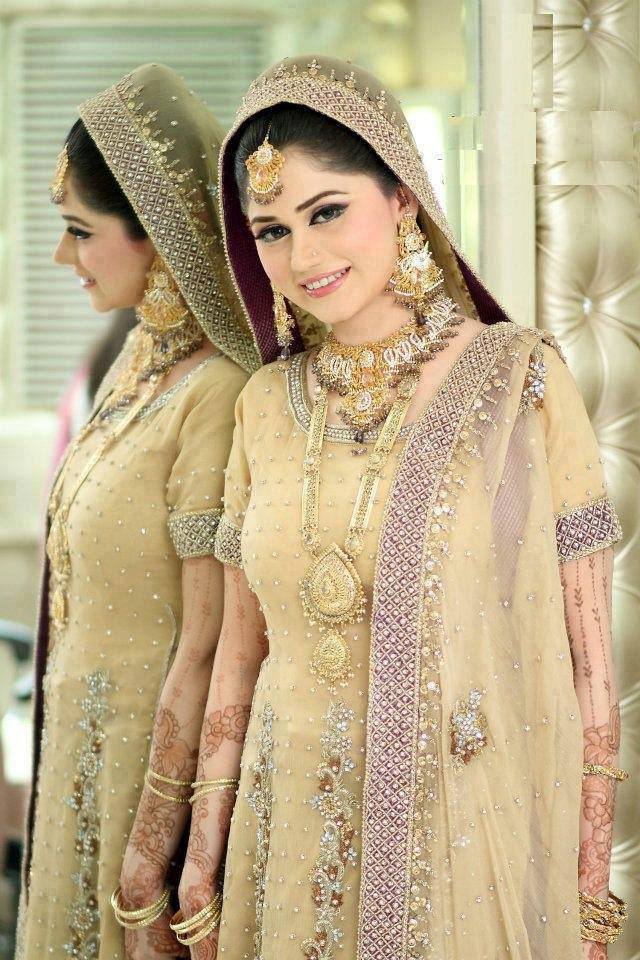Pakistani Bridal Dress Biography
Source(google.com.pk)Smart dressing is very important if only because what This is really amazing dressing of bridals. Pakistani girls love to wear on weddings. Pakistani Bridal Sharara originally dressed as a Muslim girls for wedding occasion but has a reputation among Indian women. This is one of the richest models, such as clothing art. Pakistani bridal sharara crepe satin, chiffon, Georgette and wear Silk.This was strange bridal knees and knees big flash is set to rich, full skirt has the as a symbol of dignity and honor. This dress personality on teen younger girl and mostly use on wedding occasion.
Arranged marriages in Pakistan often take long periods of time to finalize. The time from preparation until wedding day may be more than a year. When the wedding date approaches, all close relatives are invited for a typical Pakistani wedding that requires a considerable budget in order to accommodate them. In some cases, wedding dates are even postponed until the important relatives are able to arrive to the location of the reception from abroad. The wedding customs and celebrations also differ significantly depending on the geographical location as well as the families involved. However, a typical Pakistani wedding has at least three main customs involving the Henna ceremony (Rasme Henna), the vows or the Nikah which is a part of the actual wedding or Shaadi ceremony, and a subsequent Walima offered by the groom's family.
A proposal party is a reception held at the bride's house, where the groom's parents and family elders formally ask the bride's parents for her hand in marriage. In religious families, once the wedding proposal is accepted, the families read Surah Al-Fatihah, and then tea and refreshments are served. Depending on individual family traditions, the bride-to-be may also be presented with an item of jewelry and a variety of gifts.
An engagement نِسبت is a formal ceremony to mark the engagement of the couple. It is usually a small ceremony that takes place in the presence of a few close members of would-be bride's and groom’s families. Rings and other items of jewelry among affluent families are exchanged between the would-be bride and groom. Traditionally, the bride and the groom were not seated together, and the rings are placed on the bride's finger by the groom's mother or sister, and vice versa. In recent years, however, segregated functions have become a rarity and rings are usually exchanged between the couple. Prayer and blessings for the couple are then recited, and the wedding date is decided.
The Dholki or Dholak (Urdu: ڈھولکی) celebration takes its name from the percussion instrument Dholki, which is featured heavily during this wedding celebration. Traditionally, many days or even weeks before the actual wedding day, women will gather in the house of the bride at night to sing and dance while accompanied by percussion instruments. Today, this ceremony has also been reduced to a single night of singing and is often combined with Mehndi or Henna ceremony.
A Maayun Bithana ماﺌيوں بِٹهانا, is the custom of the bride entering into a state of seclusion before the wedding. In earlier centuries this would last eight to fifteen days, which, being no longer practicable, last now for a night. The bride and the bridegroom are made free of all the chores and errands around the house and are not allowed to see each other after the initiation of the period. Additionally, the bride is not allowed to leave the house, particularly after sunset. Traditional beautification rituals take place during this time.
Ubtan turmeric paste, sandalwood powder, herbs, and aromatic oils are traditionally brought by the women of the groom's household for the bride. During the Maayun ceremonies, the elder females of the groom's family bless the bride and “ubtan’ is applied to her hands and face. The Groom's sister(s) also does the same, and a thick string called a “gana” is tied to the bride’s arm. “Ubtan” is applied to the bride's skin each day leading up to the wedding. Similar ceremonies can be held for the groom, where bride's mother, sisters, cousins and friends bring “ubtan” for groom and rub it on his skin.
The ceremony is often brought to a close by the members of the household playing a game by the same name, Ubtan, whereby it is brought in huge trays and the powder is thrown at each.
Pakistani Bridal Dress Pakistani Dresses 2014 Boutique Party Wear Images Casual Design For Girls Casual Wear Salwar Kameez Photos

Pakistani Bridal Dress Pakistani Dresses 2014 Boutique Party Wear Images Casual Design For Girls Casual Wear Salwar Kameez Photos

Pakistani Bridal Dress Pakistani Dresses 2014 Boutique Party Wear Images Casual Design For Girls Casual Wear Salwar Kameez Photos

Pakistani Bridal Dress Pakistani Dresses 2014 Boutique Party Wear Images Casual Design For Girls Casual Wear Salwar Kameez Photos

Pakistani Bridal Dress Pakistani Dresses 2014 Boutique Party Wear Images Casual Design For Girls Casual Wear Salwar Kameez Photos

Pakistani Bridal Dress Pakistani Dresses 2014 Boutique Party Wear Images Casual Design For Girls Casual Wear Salwar Kameez Photos

Pakistani Bridal Dress Pakistani Dresses 2014 Boutique Party Wear Images Casual Design For Girls Casual Wear Salwar Kameez Photos
Pakistani Bridal Dress Pakistani Dresses 2014 Boutique Party Wear Images Casual Design For Girls Casual Wear Salwar Kameez Photos

Pakistani Bridal Dress Pakistani Dresses 2014 Boutique Party Wear Images Casual Design For Girls Casual Wear Salwar Kameez Photos

Pakistani Bridal Dress Pakistani Dresses 2014 Boutique Party Wear Images Casual Design For Girls Casual Wear Salwar Kameez Photos

Pakistani Bridal Dress Pakistani Dresses 2014 Boutique Party Wear Images Casual Design For Girls Casual Wear Salwar Kameez Photos

No comments:
Post a Comment